LOG#074. Dual units.
Posted: 2013/02/03 Filed under: Physmatics, Quantum Gravity, Units, natural units and metrology | Tags: Dual system of units, duality, natural units, speculative ideas 3 CommentsThe last of my three posts tonight is a mysterious dual system of units developed my rival blog (in Spanish language mainly):
http://tardigrados.wordpress.com/
His author launched an interesting but speculative dual system of units in which every physical quantity seems to have a lower and maximal bound. I have never seen such an idea published before, so I translated to English the table he posted here in Spanish language
Is duality the principle/symmetry behind this table? I don’t know for sure, but I came to some similar ideas in my own thoughts about “enhanced relativities”, so I found this table as mysterious as the constant from Pavšič units.
What do you think?
See you soon in a new blog post!
LOG#073. The G2 system.
Posted: 2013/02/03 Filed under: Physmatics, Quantum Gravity, Units, natural units and metrology | Tags: Boya, fundamental units, G2 system, natural units, Rivera, SBR units, sudarshan Leave a commentThe second paper I am going to discuss today is this one:
http://inspirehep.net/record/844954?ln=en
In Note on the natural system of units, Sudarshan, Boya and Rivera introduce a new kind of “fundamental system of units”, that we could call G2 system or the Boya-Rivera-Sudarshan system (BRS system for short). After a summary of the Gamov-Ivanenko-Landau-Okun cube (GILO cube) and the Planck natural units, they make the following question:
Can we change the gravitational constant for something else?
They ask this question due to the fact the seems to be a little different from
. Indeed, many researchers in quantum gravity use to change
with the Planck length as fundamental unit! The G2 system proposal is based in some kind of twodimensional world. Sudarshan, Boya and Rivera search for a “new constant”
such as
substitutes
in the Newton’s gravitational law.
in this new “partial” fundamental system. Therefore, we have
and the physical dimensions of time, length and mass are expressed in terms of as follows (we could use
instead of h, that is not essential here as we do know from previous discussions) :
In fact, they remark that since derives from a 2+1 dimensional world and Einstein Field equations are generally “trivial” in 2+1 spacetime,
, surprisingly, is not related to gravitation at all! We are almost “free” to fix
with some alternative procedure. As we wish to base the G2 system in well known physics, the election they do for
is the trivial one ( however I am yet thinking about what we could obtain with some non-trivial alternative definition of $lates G_2$):
and any other equivalent expression to it. Please, note that if we fix the Planck length to unit, we get , so it is equivalent to speak about
or
in a system of units where Planck length is set to the unit. However, the proposal is independent of this fact, since, as we said above, we could choose some other non-trivial definition for
, although I don’t know what kind of guide we could follow in those alternative and non-trivial definition.
The final remark I would like to make here is that, whatever we choose instead of , it is ESSENTIAL to a quantum theory of gravity, provided it exists, it works and it is “clear” from its foundational principles.
See you in my next blog post!
LOG#072. The hG system.
Posted: 2013/02/03 Filed under: Physmatics, Quantum Gravity, Units, natural units and metrology | Tags: charge-mass relationship, compton effect, fundamental theories of physics, fundamental units, G-protocol, h-protocol, hG protocols, hG system, mass pattern, observables Leave a commentBrazil is experimenting an increase of scientific production. Today, I am going to explain this brazilian paper http://arxiv.org/abs/0711.4276v2 concerning the number of fundamental constants.
The Okun cube of fundamental constant, firstly introduced by Gamov, Ivanenko and Landau, has raised some questions about what we should consider as fundamental “unit” we already had but now with more intensity. I mentioned the trialogue of fundamental constants between Veneziano, Duff and Okun himself more than a decade ago. Veneziano argued that 2 fundamental constants were well enought to fix everything. However, it is not the “accepted” and “more popular” approach in these days, but the brazilian paper about defends such a claim!
What do they claim? They basically argue that what we need is a convention for space and time measurements and nothing else. Specifically, they say that every physical observable with
can be expressed as follows:
(1)
and where are pure dimensionless numbers, while
denote “basic units” of space and time. We could argue that these two last “fundamental units” of “space and time” were “quanta” of “space” and “time”, the mythical “choraons” and “chronons” some speculative theories of Quantum Gravity seem to suggest, but it would be another different story not related to this post!
After introducing the above statement, they discuss 2 procedures to measure with clocks and rulers, what they call -protocol and
-protocol. They begin assuming some quantity in the CGS system (note that the idea is completely general and they could use the MKSA or any other traditional system of units):
(2)
where are dimensionless constants. And then, the 2 protocols are defined:
1st. G-protocol. Multiply the above equation (2) by and identify
with
or
. Rewriting all the physical quantities and laws in terms of this protocol in terms of
instead
we gain some bonuses:
i) The unit M from CGS “vanishes” or is “erased” from physical observables.
ii) G disappear from every physical law.
iii) Masses being measured in imply that from Newton’s gravitational law
we deduce that
where are units with physical dimension
.
, the gravitational constant, is some kind of conversion factor between mass and “volume acceleration”
. This G-protocol applied to the Planck constant provides
and it has dimensions of .
2nd. h-protocol. From equation (2), if we divide by and we identigy
with
we get the so-called h-protocol. The consequences are:
i) M units disappear from physical laws and quantities, as before.
ii) h is erased and vanishes from every equation, law and quantity.
iii) Masses are measured in units of , e.g., from the Compton equation we get in the h-protocol
and where are units of mass in the h-protocol with dimensions
. Therefore, h is the conversion factor between inverse areolar velocity
and mass
. In this protocol the inverse of the Compton length measures “inertia”, and indeed this fact fits with some recent proposals to determine a definition of kg independent from the old MKSA pattern (the famours iridium “thing”, which is know now not to have a 1 kg mass). Moreover, we also get that
and
The two protocols can be summarized in a nice table
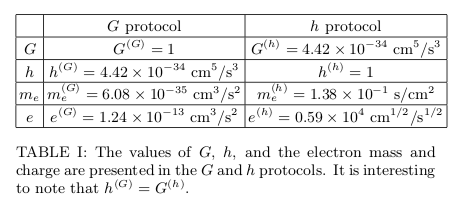 They also derive the mysterious relations between charge and mass that we saw in the previous post about Pavšič units, i.e., they also derive
They also derive the mysterious relations between charge and mass that we saw in the previous post about Pavšič units, i.e., they also derive
and it is equivalent to . Somehow, and electron is more electrical/capacitive than gravitational/elastic!
Finally, in their conclusions, they remark that two constants, instead three
seems to be well enough for physical theories, and it squashes or squeezes the Gamov-Ivanenko-Landau-Okun (GILO) cube to a nice plane. I include the two final figure for completion, but I urge you to read their whole paper to get a global view before you look at them.
Are 2 fundamental constants enough? Are Veneziano (from a completely different viewpoint) and these brazilian physicists right? Time will tell, but I find interesting these thoughts!
See you soon in another wonderful post about Physmatics and system of units!
LOG#071. Pavšič Units.
Posted: 2013/01/31 Filed under: Physmatics, Units, natural units and metrology | Tags: D-system, dilationally invariant system, Landscape of Theoretical Physics, Matej Pavŝiĉ, natural units 3 CommentsFollowing the thread I began in the previous blog post, today we are going to learn about a non common but very general and universal system of natural units. They were officiallly introduced without name in the literature, until a physicist realized its importance, to my knowledge, by first time.
In his book, The Landscape of Theoretical Physics: A Global View, available here and here for free, the slovenian physicist Matej Pavšič introduced a dilationally invariant system of units, where “all” the fundamental “constants” are set to the unit. More precisely, he defines the D-system or Pavšič units M system characterized by
and where the Coulomb constant so
. This sistem of units, let me call it M (for Matej) or D-system (we will see later the meaning of D), is very useful but it has not been discussed in the literature deeper, unlike the case of natural HEP units, Stoney units or the Planck units.
We have seen in the previous post that addapted system of units do exist where the physical quantities lack any spurious conversion constant (like c or any power or it, the Planck constant and any power of it, and so on). Indeed, we could say that these “fundamental” constants are yet there, but they are “invisible” due to the election of some clever system of units ( the so-called natural units).
The M system of units or D-system ( following M. Pavšič) defines a dilationally invariant system of units, and it is the fact that this system has some special behaviour under “dilatations” why it receives such a name. In the MKSA system, the quantities of this system are written as follows:
We can compare MKSA units and D-system units. Firstly, in MKSA, we have:
However, in D units, we also have:
Of course, this result is the same than the Planck system of units. In addition to these equations, we can also define:
and
Furthermore, we can also set the electric charge to “mass” as follows (in the D-system):
Length is defined as the radius a classical particle with mass M and a charge elementary e would have. In MKSA, we easily derive:
By the other hand, in terms of units D, it yields
Thus, length seems to be the ratio between “squared charge” and “mass” somehow from D units, i.e., if we further impose that , we would “deduce” that
or more generally the relationship
(recall the striking convergence to the charge-mass equivalence from these dimensional arguments as it does also happen in black hole physics!). The classical radius of the electron is, as every physicist knows:
in MKSA units, but it is
in D units. Taking the ratio , it yields:
and thus, we can write in D units
This equation says that mass is equivalent to charge up to a tiny constant, denoted by . This dimensionless constant is very mysterious and it has not been discussed in the literature as far as I know excepting in that M. Pavšič book! Its reciprocal value is also a curious number:
This number is roughly 1/295 times the Avogrado constant . Matej Pavšič also mentions that the ratio
or its reciprocal represents the “scale of length” of the classical electron radius relative to the length L, and we have
The next table provides the conversion factors between D-system units and MKSA units:
Furthermore, the D units and also
, plus the conventional and commonly known as
are also invariant under dilatations! It is quite a claim, so let me review the arguments that Pavšič gives in his book. If we make a dilatation transformation of position, linear momentum, mass, force and acceleration (after a “scale transformation”), we write:
Instead of the inhomogeneous coordinates one can introduce the homogeneous coordinates
where
are invariant under dilatations provided that the quantity κ transforms as follows:
For instance, if initially , then after applying a dilatation, say by the factor ρ = 3, we have
. Setting
fixes the scale transformation relative to some homogeneous coordinate.
If we write a given equation we can check its consistency by comparing the dimension of its left hand and right hand side. In the MKSA system the dimensional control is in checking the powers of meters, kilograms, seconds and ampères on both sides of the equation. Moreover, even the Einstein Field Equations of gravity
can be expressed in units where is “visible” as
If we choose κ = 1 then the equations for this particular choice correspond to the usual Einstein Field Equations, and we may use either the MKSA system or the D system.
In the D-system, some equations simplify further, even more than in Planck units! Let’s see some interesting uncommon equations in this new system of units:
The final part of this nice post corresponds to a nice exercise included in the Pavšič book. Suppose you are given an equation in the D system, e.g.,
How can we turn it to usual MKSA units? Using conversion constants, we can rewrite the previous equation in the next way:
If we put 1D = 1 then the right hand side of the latter equation is a pure dimensionless quantity. If we wish to obtain a quantity of the dimension of length we have to insert the factor:
and we finally obtain the Böhr radius:
Instead of rewriting equations from the D system in the MKSA system, we can keep all the equations in the D system and perform all the algebraic and numerical calculations in the D units. If we wish to know the numerical results in terms of the MKSA units, we can use the numbers of Table 2 above. For instance, in the previous example, going backwards, we have
Taking D units of length, from Table 1, we read off that and we obtain the classical result
Let me quote M. Pavšič:
“(…)However, I do not propose to replace the international MKSA system with the D system. I only wish to recall that most modern theoretical works do not use the MKSA system and that it is often very tedious to obtain the results in meters, seconds, kilograms and ampères. (…)besides the Planck length, Planck time and the Planck mass, which are composed of the fundamental constants, , we have also introduced (see Table 2) the corresponding electromagnetic quantity, namely the charge
(or, equivalently, the current and the potential difference), by bringing into play the fundamental constant . We have then extended the Planck system of units in which
to a more complete system where
in order to incorporate all known sorts of physical quantities(…).”
Remarkably, at the end, M. Pavšič points out a classical paper by J.M. Levy-Leblond, see here:http://inspirehep.net/record/128108 , in which, Matej says, is clearly stated that our progress in understanding the unity of nature follows the direction of eliminating from theories various (inessential) numerical constants with the improper name of “fundamental” constants. In fact, those constants are merely the constants which result from our unnatural choice of units, the choice due to our incomplete understanding of the unified theory behind.
Matej Pavšič has become a blogger recently (you can find his site in my links on the right or here) and he has also a nice webpage about his research and lots of interesting topics. He has also studied tachyons, extended objects, geometric algebra, Clifford spaces (C-spaces), brane worlds, relativistic dynamics with an invariant evolution parameter (the so-called Stuckelberg formalism), Kaluza-Klein theories and many other interesting topics. With Carlos Castro Perelman, he is one of the proponents of the theory of relativity in Clifford spaces (C-spaces), an extension of special relativity/general relativity/QFT including grassmann valued quantities and arbitrary signatures on equal footing, but living NOT in spacetime but in some kind of nontrivial and purely algebraic space. You can visit his page and have a look to his works here.
Have you liked this post? Let me know. And be right back for my next communication! Physics is cool, Physmatics is cool and Mathematics is an incredible language for Physmatics!
LOG#070. Natural Units.
Posted: 2013/01/30 Filed under: Classical and Quantum Fields, Cosmology, Gravitational theories, Physmatics, Quantum Gravity, Relativity, The Standard Model: Basics, Units, natural units and metrology | Tags: amount of substance, atomic units, Boltzmann constant, coulomb constant, electric charge, electric current, electric permitivy of vacuum, electromagnetism, ELKO field, Fritzsch-Xing plot, geometrized units, gravitation, gravitational constant, hep units, luminous intensity, mass, mass dimension of fields, MKSA units, mole, natural units, Okun cube, Planck constant, planck units, QCD units, Quantum Gravity, schrödinger units, space, spacetime, speed of light, stoney units, time, TOE, vacuum 1 CommentHappy New Year 2013 to everyone and everywhere!
Let me apologize, first of all, by my absence… I have been busy, trying to find my path and way in my field, and I am busy yet, but finally I could not resist without a new blog boost… After all, you should know the fact I have enough materials to write many new things.
So, what’s next? I will dedicate some blog posts to discuss a nice topic I began before, talking about a classic paper on the subject here:
https://thespectrumofriemannium.wordpress.com/2012/11/18/log054-barrow-units/
The topic is going to be pretty simple: natural units in Physics.
First of all, let me point out that the election of any system of units is, a priori, totally conventional. You are free to choose any kind of units for physical magnitudes. Of course, that is not very clever if you have to report data, so everyone can realize what you do and report. Scientists have some definitions and popular systems of units that make the process pretty simpler than in the daily life. Then, we need some general conventions about “units”. Indeed, the traditional wisdom is to use the international system of units, or S (Iabbreviated SI from French language: Le Système international d’unités). There, you can find seven fundamental magnitudes and seven fundamental (or “natural”) units:
1) Space:
2) Time:
3) Mass:
4) Temperature:
5) Electric intensity:
6) Luminous intensity:
7) Amount of substance:
The dependence between these 7 great units and even their definitions can be found here http://en.wikipedia.org/wiki/International_System_of_Units and references therein. I can not resist to show you the beautiful graph of the 7 wonderful units that this wikipedia article shows you about their “interdependence”:
In Physics, when you build a radical new theory, generally it has the power to introduce a relevant scale or system of units. Specially, the Special Theory of Relativity, and the Quantum Mechanics are such theories. General Relativity and Statistical Physics (Statistical Mechanics) have also intrinsic “universal constants”, or, likely, to be more precise, they allow the introduction of some “more convenient” system of units than those you have ever heard ( metric system, SI, MKS, cgs, …). When I spoke about Barrow units (see previous comment above) in this blog, we realized that dimensionality (both mathematical and “physical”), and fundamental theories are bound to the election of some “simpler” units. Those “simpler” units are what we usually call “natural units”. I am not a big fan of such terminology. It is confusing a little bit. Maybe, it would be more interesting and appropiate to call them “addapted X units” or “scaled X units”, where X denotes “relativistic, quantum,…”. Anyway, the name “natural” is popular and it is likely impossible to change the habits.
In fact, we have to distinguish several “kinds” of natural units. First of all, let me list “fundamental and universal” constants in different theories accepted at current time:
1. Boltzmann constant: .
Essential in Statistical Mechanics, both classical and quantum. It measures “entropy”/”information”. The fundamental equation is:
It provides a link between the microphysics and the macrophysics ( it is the code behind the equation above). It can be understood somehow as a measure of the “energetic content” of an individual particle or state at a given temperature. Common values for this constant are:
Statistical Physics states that there is a minimum unit of entropy or a minimal value of energy at any given temperature. Physical dimensions of this constant are thus entropy, or since ,
, where t denotes here dimension of temperature.
2. Speed of light. .
From classical electromagnetism:
The speed of light, according to the postulates of special relativity, is a universal constant. It is frame INDEPENDENT. This fact is at the root of many of the surprising results of special relativity, and it took time to be understood. Moreover, it also connects space and time in a powerful unified formalism, so space and time merge into spacetime, as we do know and we have studied long ago in this blog. The spacetime interval in a D=3+1 dimensional space and two arbitrary events reads:
In fact, you can observe that “c” is the conversion factor between time-like and space-like coordinates. How big the speed of light is? Well, it is a relatively large number from our common and ordinary perception. It is exactly:
although you often take it as . However, it is the speed of electromagnetic waves in vacuum, no matter where you are in this Universe/Polyverse. At least, experiments are consistent with such an statement. Moreover, it shows that
is also the conversion factor between energy and momentum, since
and is the conversion factor between rest mass and pure energy, because, as everybody knows,
! According to the special theory of relativity, normal matter can never exceed the speed of light. Therefore, the speed of light is the maximum velocity in Nature, at least if specially relativity holds. Physical dimensions of c are
, where L denotes length dimension and T denotes time dimension (please, don’t confuse it with temperature despite the capital same letter for both symbols).
3. Planck’s constant. or generally rationalized
.
Planck’s constant (or its rationalized version), is the fundamental universal constant in Quantum Physics (Quantum Mechanics, Quantum Field Theory). It gives
Indeed, quanta are the minimal units of energy. That is, you can not divide further a quantum of light, since it is indivisible by definition! Furthermore, the de Broglie relationship relates momentum and wavelength for any particle, and it emerges from the combination of special relativity and the quantum hypothesis:
In the case of massive particles, it yields
In the case of massless particles (photons, gluons, gravitons,…)
or
Planck’s constant also appears to be essential to the uncertainty principle of Heisenberg:
Some particularly important values of this constant are:
It is also useful to know that
or
or
Planck constant has dimension of . Physical dimensions of this constant coincide also with angular momentum (spin), i.e., with
.
4. Gravitational constant. .
Apparently, it is not like the others but it can also define some particular scale when combined with Special Relativity. Without entering into further details (since I have not discussed General Relativity yet in this blog), we can calculate the escape velocity of a body moving at the speed of light
with
implies a new length scale where gravitational relativistic effects do appear, the so-called Schwarzschild radius
:
5. Electric fundamental charge. .
It is generally chosen as fundamental charge the electric charge of the positron (positive charged “electron”). Its value is:
where C denotes Coulomb. Of course, if you know about quarks with a fraction of this charge, you could ask why we prefer this one. Really, it is only a question of hystory of Science, since electrons were discovered first (and positrons). Quarks, with one third or two thirds of this amount of elementary charge, were discovered later, but you could define the fundamental unit of charge as multiple or entire fraction of this charge. Moreover, as far as we know, electrons are “elementary”/”fundamental” entities, so, we can use this charge as unit and we can define quark charges in terms of it too. Electric charge is not a fundamental unit in the SI system of units. Charge flow, or electric current, is.
An amazing property of the above 5 constants is that they are “universal”. And, for instance, energy is related with other magnitudes in theories where the above constants are present in a really wonderful and unified manner:
Caution: k is not the Boltzmann constant but the wave number.
There is a sixth “fundamental” constant related to electromagnetism, but it is also related to the speed of light, the electric charge and the Planck’s constant in a very sutble way. Let me introduce you it too…
6. Coulomb constant. .
This is a second constant related to classical electromagnetism, like the speed of light in vacuum. Coulomb’s constant, the electric force constant, or the electrostatic constant (denoted ) is a proportionality factor that takes part in equations relating electric force between point charges, and indirectly it also appears (depending on your system of units) in expressions for electric fields of charge distributions. Coulomb’s law reads
Its experimental value is
Generally, the Coulomb constant is dropped out and it is usually preferred to express everything using the electric permitivity of vacuum and/or numerical factors depending on the pi number
if you choose the gaussian system of units (read this wikipedia article http://en.wikipedia.org/wiki/Gaussian_system_of_units ), the CGS system, or some hybrid units based on them.
H.E.P. units
High Energy Physicists use to employ units in which the velocity is measured in fractions of the speed of light in vacuum, and the action/angular momentum is some multiple of the Planck’s constant. These conditions are equivalent to set
Complementarily, or not, depending on your tastes and preferences, you can also set the Boltzmann’s constant to the unit as well
and thus the complete HEP system is defined if you set
This “natural” system of units is lacking yet a scale of energy. Then, it is generally added the electron-volt as auxiliary quantity defining the reference energy scale. Despite the fact that this is not a “natural unit” in the proper sense because it is defined by a natural property, the electric charge, and the anthropogenic unit of electric potential, the volt. The SI prefixes multiples of eV are used as well: keV, MeV, GeV, etc. Here, the eV is used as reference energy quantity, and with the above election of “elementary/natural units” (or any other auxiliary unit of energy), any quantity can be expressed. For example, a distance of 1 m can be expressed in terms of eV, in natural units, as
This system of units have remarkable conversion factors
A) of length is equal to
B) of mass is equal to
C) of time is equal to
D) of temperature is equal to
E) of electric charge in the Lorentz-Heaviside system of units is equal to
F) of electric charge in the Gaussian system of units is equal to
This system of units, therefore, leaves free only the energy scale (generally it is chosen the electron-volt) and the electric measure of fundamentl charge. Every other unit can be related to energy/charge. It is truly remarkable than doing this (turning invisible the above three constants) you can “unify” different magnitudes due to the fact these conventions make them equivalent. For instance, with natural units:
1) Length=Time=1/Energy=1/Mass.
It is due to ,
and
equations. Setting
and
or
provides
,
and
.
Note that natural units turn invisible the units we set to the unit! That is the key of the procedure. It simplifies equations and expressions. Of course, you must be careful when you reintroduce constants!
2) Energy=Mass=Momemntum=Temperature.
It is due to ,
and
again.
One extra bonus for theoretical physicists is that natural units allow to build and write proper lagrangians and hamiltonians (certain mathematical operators containing the dynamics of the system enconded in them), or equivalently the action functional, with only the energy or “mass” dimension as “free parameter”. Let me show how it works.
Natural units in HEP identify length and time dimensions. Thus . Planck’s constant allows us to identify those 2 dimensions with 1/Energy (reciprocals of energy) physical dimensions. Therefore, in HEP units, we have
The speed of light identifies energy and mass, and thus, we can often heard about “mass-dimension” of a lagrangian in the following sense. HEP units can be thought as defining “everything” in terms of energy, from the pure dimensional ground. That is, every physical dimension is (in HEP units) defined by a power of energy:
Thus, we can refer to any magnitude simply saying the power of such physical dimension (or you can think logarithmically to understand it easier if you wish). With this convention, and recalling that energy dimension is mass dimension, we have that
and
Using these arguments, the action functional is a pure dimensionless quantity, and thus, in D=4 spacetime dimensions, lagrangian densities must have dimension 4 ( or dimension D is a general spacetime).
In D=4 spacetime dimensions, it can be easily showed that
where is a scalar field,
is a vector field (like the electromagnetic or non-abelian vector gauge fields), and
are a Dirac spinor, a Majorana spinor, and
are Weyl spinors (of different chiralities). Supersymmetry (or SUSY) allows for anticommuting c-numbers (or Grassmann numbers) and it forces to introduce auxiliary parameters with mass dimension
. They are the so-called SUSY transformation parameters
. There are some speculative spinors called ELKO fields that could be non-standandard spinor fields with mass dimension one! But it is an advanced topic I am not going to discuss here today. In general D spacetime dimensions a scalar (or vector) field would have mass dimension
, and a spinor/fermionic field in D dimensions has generally
mass dimension (excepting the auxiliary SUSY grassmanian fields and the exotic idea of ELKO fields). This dimensional analysis is very useful when theoretical physicists build up interacting lagrangians, since we can guess the structure of interaction looking at purely dimensional arguments every possible operator entering into the action/lagrangian density! In summary, therefore, for any D:
Remark (for QFT experts only): Don’t confuse mass dimension with the final transverse polarization degrees or “degrees of freedom” of a particular field, i.e., “components” minus “gauge constraints”. E.g.: a gauge vector field has degrees of freedom in D dimensions. They are different concepts (although both closely related to the spacetime dimension where the field “lives”).
In summary:
i) HEP units are based on QM (Quantum Mechanics), SR (Special Relativity) and Statistical Mechanics (Entropy and Thermodynamics).
ii) HEP units need to introduce a free energy scale, and it generally drives us to use the eV or electron-volt as auxiliary energy scale.
iii) HEP units are useful to dimensional analysis of lagrangians (and hamiltonians) up to “mass dimension”.
Stoney Units
In Physics, the Stoney units form a alternative set of natural units named after the Irish physicist George Johnstone Stoney, who first introduced them as we know it today in 1881. However, he presented the idea in a lecture entitled “On the Physical Units of Nature” delivered to the British Association before that date, in 1874. They are the first historical example of natural units and “unification scale” somehow. Stoney units are rarely used in modern physics for calculations, but they are of historical interest but some people like Wilczek has written about them (see, e.g., http://arxiv.org/abs/0708.4361). These units of measurement were designed so that certain fundamental physical constants are taken as reference basis without the Planck scale being explicit, quite a remarkable fact! The set of constants that Stoney used as base units is the following:
A) Electric charge, .
B) Speed of light in vacuum, .
C) Gravitational constant, .
D) The Reciprocal of Coulomb constant, .
Stony units are built when you set these four constants to the unit, i.e., equivalently, the Stoney System of Units (S) is determined by the assignments:
Interestingly, in this system of units, the Planck constant is not equal to the unit and it is not “fundamental” (Wilczek remarked this fact here ) but:
Today, Planck units are more popular Planck than Stoney units in modern physics, and even there are many physicists who don’t know about the Stoney Units! In fact, Stoney was one of the first scientists to understand that electric charge was quantized!; from this quantization he deduced the units that are now named after him.
The Stoney length and the Stoney energy are collectively called the Stoney scale, and they are not far from the Planck length and the Planck energy, the Planck scale. The Stoney scale and the Planck scale are the length and energy scales at which quantum processes and gravity occur together. At these scales, a unified theory of physics is thus likely required. The only notable attempt to construct such a theory from the Stoney scale was that of H. Weyl, who associated a gravitational unit of charge with the Stoney length and who appears to have inspired Dirac’s fascination with the large number hypothesis. Since then, the Stoney scale has been largely neglected in the development of modern physics, although it is occasionally discussed to this day. Wilczek likes to point out that, in Stoney Units, QM would be an emergent phenomenon/theory, since the Planck constant wouldn’t be present directly but as a combination of different constants. By the other hand, the Planck scale is valid for all known interactions, and does not give prominence to the electromagnetic interaction, as the Stoney scale does. That is, in Stoney Units, both gravitation and electromagnetism are on equal footing, unlike the Planck units, where only the speed of light is used and there is no more connections to electromagnetism, at least, in a clean way like the Stoney Units do. Be aware, sometimes, rarely though, Planck units are referred to as Planck-Stoney units.
What are the most interesting Stoney system values? Here you are the most remarkable results:
1) Stoney Length, .
2) Stoney Mass, .
3) Stoney Energy, .
4) Stoney Time, .
5) Stoney Charge, .
6) Stoney Temperature, .
Planck Units
The reference constants to this natural system of units (generally denoted by P) are the following 4 constants:
1) Gravitational constant.
2) Speed of light. .
3) Planck constant or rationalized Planck constant. .
4) Boltzmann constant. .
The Planck units are got when you set these 4 constants to the unit, i.e.,
It is often said that Planck units are a system of natural units that is not defined in terms of properties of any prototype, physical object, or even features of any fundamental particle. They only refer to the basic structure of the laws of physics: c and G are part of the structure of classical spacetime in the relativistic theory of gravitation, also known as general relativity, and ℏ captures the relationship between energy and frequency which is at the foundation of elementary quantum mechanics. This is the reason why Planck units particularly useful and common in theories of quantum gravity, including string theory or loop quantum gravity.
This system defines some limit magnitudes, as follows:
1) Planck Length, .
2) Planck Time, .
3) Planck Mass, .
4) Planck Energy, .
5) Planck charge, .
In Lorentz-Heaviside electromagnetic units
In Gaussian electromagnetic units
6) Planck temperature, .
From these “fundamental” magnitudes we can build many derived quantities in the Planck System:
1) Planck area.
2) Planck volume.
3) Planck momentum.
A relatively “small” momentum!
4) Planck force.
It is independent from Planck constant! Moreover, the Planck acceleration is
5) Planck Power.
6) Planck density.
Planck density energy would be equal to
7) Planck angular frequency.
8) Planck pressure.
Note that Planck pressure IS the Planck density energy!
9) Planck current.
10) Planck voltage.
11) Planck impedance.
A relatively small impedance!
12) Planck capacitor.
Interestingly, it depends on the gravitational constant!
Some Planck units are suitable for measuring quantities that are familiar from daily experience. In particular:
1 Planck mass is about 22 micrograms.
1 Planck momentum is about 6.5 kg m/s
1 Planck energy is about 500kWh.
1 Planck charge is about 11 elementary (electronic) charges.
1 Planck impendance is almost 30 ohms.
Moreover:
i) A speed of 1 Planck length per Planck time is the speed of light, the maximum possible speed in special relativity.
ii) To understand the Planck Era and “before” (if it has sense), supposing QM holds yet there, we need a quantum theory of gravity to be available there. There is no such a theory though, right now. Therefore, we have to wait if these ideas are right or not.
iii) It is believed that at Planck temperature, the whole symmetry of the Universe was “perfect” in the sense the four fundamental foces were “unified” somehow. We have only some vague notios about how that theory of everything (TOE) would be.
The physical dimensions of the known Universe in terms of Planck units are “dramatic”:
i) Age of the Universe is about .
ii) Diameter of the observable Universe is about
iii) Current temperature of the Universe is about
iv) The observed cosmological constant is about
v) The mass of the Universe is about .
vi) The Hubble constant is
Schrödinger Units
The Schrödinger Units do not obviously contain the term c, the speed of light in a vacuum. However, within the term of the Permittivity of Free Space [i.e., electric constant or vacuum permittivity], and the speed of light plays a part in that particular computation. The vacuum permittivity results from the reciprocal of the speed of light squared times the magnetic constant. So, even though the speed of light is not apparent in the Schrödinger equations it does exist buried within its terms and therefore influences the decimal placement issue within square roots. The essence of Schrödinger units are the following constants:
A) Gravitational constant .
B) Planck constant .
C) Boltzmann constant .
D) Coulomb constant or equivalently the electric permitivity of free space/vacuum .
E) The electric charge of the positron .
In this sistem we have
1) Schrödinger Length .
2) Schrödinger time .
3) Schrödinger mass .
4) Schrödinger energy .
5) Schrödinger charge .
6) Schrödinger temperature .
Atomic Units
There are two alternative systems of atomic units, closely related:
1) Hartree atomic units:
and
2) Rydberg atomic units:
and
There, is the electron mass and
is the electromagnetic fine structure constant. These units are designed to simplify atomic and molecular physics and chemistry, especially the quantities related to the hydrogen atom, and they are widely used in these fields. The Hartree units were first proposed by Doublas Hartree, and they are more common than the Rydberg units.
The units are adapted to characterize the behavior of an electron in the ground state of a hydrogen atom. For example, using the Hartree convention, in the Böhr model of the hydrogen atom, an electron in the ground state has orbital velocity = 1, orbital radius = 1, angular momentum = 1, ionization energy equal to 1/2, and so on.
Some quantities in the Hartree system of units are:
1) Atomic Length (also called Böhr radius):
2) Atomic Time:
3) Atomic Mass:
4) Atomic Energy:
5) Atomic electric Charge:
6) Atomic temperature:
The fundamental unit of energy is called the Hartree energy in the Hartree system and the Rydberg energy in the Rydberg system. They differ by a factor of 2. The speed of light is relatively large in atomic units (137 in Hartree or 274 in Rydberg), which comes from the fact that an electron in hydrogen tends to move much slower than the speed of light. The gravitational constant is extremely small in atomic units (about 10−45), which comes from the fact that the gravitational force between two electrons is far weaker than the Coulomb force . The unit length, LA, is the so-called and well known Böhr radius, a0.
The values of c and e shown above imply that , as in Gaussian units, not Lorentz-Heaviside units. However, hybrids of the Gaussian and Lorentz–Heaviside units are sometimes used, leading to inconsistent conventions for magnetism-related units. Be aware of these issues!
QCD Units
In the framework of Quantum Chromodynamics, a quantum field theory (QFT) we know as QCD, we can define the QCD system of units based on:
1) QCD Length .
and where is the proton mass (please, don’t confuse it with the Planck mass
).
2) QCD Time .
3) QCD Mass .
4) QCD Energy .
Thus, QCD energy is about 1 GeV!
5) QCD Temperature .
6) QCD Charge .
In Heaviside-Lorent units:
In Gaussian units:
Geometrized Units
The geometrized unit system, used in general relativity, is not a completely defined system. In this system, the base physical units are chosen so that the speed of light and the gravitational constant are set equal to unity. Other units may be treated however desired. By normalizing appropriate other units, geometrized units become identical to Planck units. That is, we set:
and the remaining constants are set to the unit according to your needs and tastes.
Conversion Factors
This table from wikipedia is very useful:
where:
i) is the fine-structure constant, approximately 0.007297.
ii) is the gravitational fine-structure constant.
Some conversion factors for geometrized units are also available:
Conversion from kg, s, C, K into m:
[m/kg]
[m/s]
[m/C]
[m/K]
Conversion from m, s, C, K into kg:
[kg/m]
[kg/s]
[kg/C]
[kg/K]
Conversion from m, kg, C, K into s
[s/m]
[s/kg]
[s/C]
[s/K]
Conversion from m, kg, s, K into C
[C/m]
[C/kg]
[C/s]
[C/K]
Conversion from m, kg, s, C into K
[K/m]
[K/kg]
[K/s]
[K/C]
Or you can read off factors from this table as well:
and
Advantages and Disadvantages of Natural Units
Natural units have some advantages (“Pro”):
1) Equations and mathematical expressions are simpler in Natural Units.
2) Natural units allow for the match between apparently different physical magnitudes.
3) Some natural units are independent from “prototypes” or “external patterns” beyond some clever and trivial conventions.
4) They can help to unify different physical concetps.
However, natural units have also some disadvantages (“Cons”):
1) They generally provide less precise measurements or quantities.
2) They can be ill-defined/redundant and own some ambiguity. It is also caused by the fact that some natural units differ by numerical factors of pi and/or pure numbers, so they can not help us to understand the origin of some pure numbers (adimensional prefactors) in general.
Moreover, you must not forget that natural units are “human” in the sense you can addapt them to your own needs, and indeed,you can create your own particular system of natural units! However, said this, you can understand the main key point: fundamental theories are who finally hint what “numbers”/”magnitudes” determine a system of “natural units”.
Remark: the smart designer of a system of natural unit systems must choose a few of these constants to normalize (set equal to 1). It is not possible to normalize just any set of constants. For example, the mass of a proton and the mass of an electron cannot both be normalized: if the mass of an electron is defined to be 1, then the mass of a proton has to be . In a less trivial example, the fine-structure constant, α≈1/137, cannot be set to 1, because it is a dimensionless number. The fine-structure constant is related to other fundamental constants through a very known equation:
where is the Coulomb constant, e is the positron electric charge (elementary charge), ℏ is the reduced Planck constant, and c is the again the speed of light in vaccuum. It is believed that in a normal theory is not possible to simultaneously normalize all four of the constants c, ℏ, e, and kC.
Fritzsch-Xing plot
Fritzsch and Xing have developed a very beautiful plot of the fundamental constants in Nature (those coming from gravitation and the Standard Model). I can not avoid to include it here in the 2 versions I have seen it. The first one is “serious”, with 29 “fundamental constants”:
However, I prefer the “fun version” of this plot. This second version is very cool and it includes 28 “fundamental constants”:
The Okun Cube
Long ago, L.B. Okun provided a very interesting way to think about the Planck units and their meaning, at least from current knowledge of physics! He imagined a cube in 3d in which we have 3 different axis. Planck units are defined as we have seen above by 3 constants plus the Boltzmann constant. Imagine we arrange one axis for c-Units, one axis for
-units and one more for
-units. The result is a wonderful cube:
Or equivalently, sometimes it is seen as an equivalent sketch ( note the Planck constant is NOT rationalized in the next cube, but it does not matter for this graphical representation):
Classical physics (CP) corresponds to the vanishing of the 3 constants, i.e., to the origin .
Newtonian mechanics (NM) , or more precisely newtonian gravity plus classical mechanics, corresponds to the “point” .
Special relativity (SR) corresponds to the point , i.e., to “points” where relativistic effects are important due to velocities close to the speed of light.
Quantum mechanics (QM) corresponds to the point , i.e., to “points” where the action/angular momentum fundamental unit is important, like the photoelectric effect or the blackbody radiation.
Quantum Field Theory (QFT) corresponds to the point , i.e, to “points” where both, SR and QM are important, that is, to situations where you can create/annihilate pairs, the “particle” number is not conserved (but the particle-antiparticle number IS), and subatomic particles manifest theirselves simultaneously with quantum and relativistic features.
Quantum Gravity (QG) would correspond to the point where gravity is quantum itself. We have no theory of quantum gravity yet, but some speculative trials are effective versions of (super)-string theory/M-theory, loop quantum gravity (LQG) and some others.
Finally, the Theory Of Everything (TOE) would be the theory in the last free corner, that arising in the vertex . Superstring theories/M-theory are the only serious canditate to TOE so far. LQG does not generally introduce matter fields (some recent trials are pushing into that direction, though) so it is not a TOE candidate right now.
Some final remarks and questions
1) Are fundamental “constants” really constant? Do they vary with energy or time?
2) How many fundamental constants are there? This questions has provided lots of discussions. One of the most famous was this one:
http://arxiv.org/abs/physics/0110060
The trialogue (or dialogue if you are precise with words) above discussed the opinions by 3 eminent physicists about the number of fundamental constants: Michael Duff suggested zero, Gabriel Veneziano argued that there are only 2 fundamental constants while L.B. Okun defended there are 3 fundamental constants
3) Should the cosmological constant be included as a new fundamental constant? The cosmological constant behaves as a constant from current cosmological measurements and cosmological data fits, but is it truly constant? It seems to be…But we are not sure. Quintessence models (some of them related to inflationary Universes) suggest that it could vary on cosmological scales very slowly. However, the data strongly suggest that
It is simple, but it is not understood the ultimate nature of such a “fluid” because we don’t know what kind of “stuff” (either particles or fields) can make the cosmological constant be so tiny and so abundant (about the 72% of the Universe is “dark energy”/cosmological constant) as it seems to be. We do know it can not be “known particles”. Dark energy behaves as a repulsive force, some kind of pressure/antigravitation on cosmological scales. We suspect it could be some kind of scalar field but there are many other alternatives that “mimic” a cosmological constant. If we identify the cosmological constant with the vacuum energy we obtain about 122 orders of magnitude of mismatch between theory and observations. A really bad “prediction”, one of the worst predictions in the history of physics!
Be natural and stay tuned!
LOG#054. Barrow units.
Posted: 2012/11/18 Filed under: Physmatics, Units, natural units and metrology 3 CommentsIn a nice paper titled Dimensionality, see here http://rsta.royalsocietypublishing.org/content/310/1512/337.short , the physicist John Barrow studied the rôle of known fundamental constants and their links to the dimensionality of space-time.
I will review the main ideas appearing in that paper, and some interesting conclusions we can obtain from it.
Firstly, Barrow points out the connection between some equations and dimensionality. For instance, the Poisson-Laplace equation in any dimension provides a potential function
and a force
whenever spherical symmetry holds . A short-range modification of such a potential (force) is given by screening potentials, also called Yukawa potentials. In the simplest case, D=3, we get:
The atomic stability can be read from a really simple condition for the energy with a Coulomb potential:
Imposing , we obtain
Indeed, Ehrenfest proved that for atoms in dimensions, those conditions generalize into:
This fact means that only 3d space (4D spacetime) appears to have the beautiful and nice properties necessary for transmissions of high fidelity signal due to the simultaneous realization of reverberationless and distortionless propagation of information.
Barrow realized that we can build a dimensionless basic and fundamental system of units, that we can call Barrow units system (or Barrow system). The dimensionless quantity of this system is made of 4 constants:
1st. The electric charge .
Its physical units are or
2nd. The Planck constant . Barrow used the pure Planck constant but we will use instead the rationalized Planck constant
.
Its physical units are
3rd. The Newton gravitational constant .
Its physical units are
4th. The speed of light .
Its physical units are
From these 4 fundamental constants, the Barrow system formed by allows us to create a dimensionless constant of Nature
. It is given by the combination:
Remarks:
1) are special dimensions since, in those dimensions, we observe the absence of
i) The electric charge/electromagnetic coupling constant in D=1.
ii) Planck’s constant/The quantum theory fundamental constant in D=2.
iii) Gravitational Newton constant/gravitational Newton coupling constant in D=3.
iv) The speed of light/The fundamental constant of special relativity in D=4.
2) Dimensionless units for all probably will be redefined if some new fundamental constant arises. It could be due to the structure of GUT (Gran Unified Theory) or Quantum Gravity (QG).
3) Fractal dimensions with non-integer values are not allowed in this classical setting. We note that strange attractors provide objects with non-integer dimensions .
4) A fundamental length L can emerge from quantum gravity (QG). In the most general case, it would imply
where and
is some gauge coupling. If the gauge coupling is “weak”, it could be about
,
or smaller, and thus, the fundamental length could be larger than Planck length. This result can be obtained from basic electromagnetic, gravitational, relativistic and quantum theories. We begin from
From special relativity and from quantum theory
or equivalently
Therefore,
We introduce or the electromagnetic fine structure constant
. Then,
Q.E.D.
5) Fractal dimension theory will not be considered in this post, but it deserves further study.
6) We will check that the dimensionless fundamental constant for the Barrow system is . Using the physical dimensions of the 4 constants above, we get:
Thus, for M, L and T, we deduce:
Q.E.D.

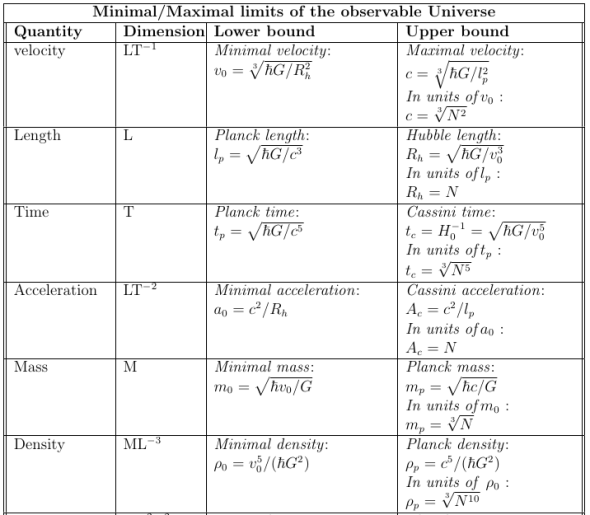
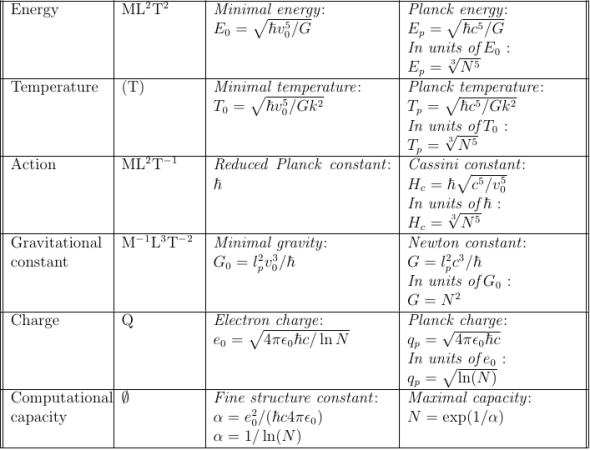
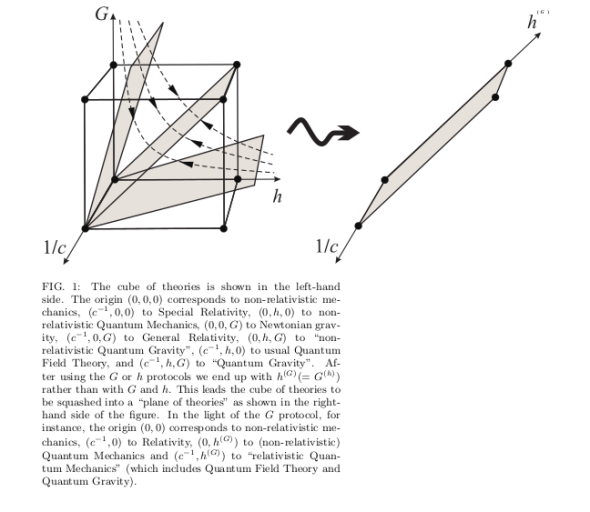
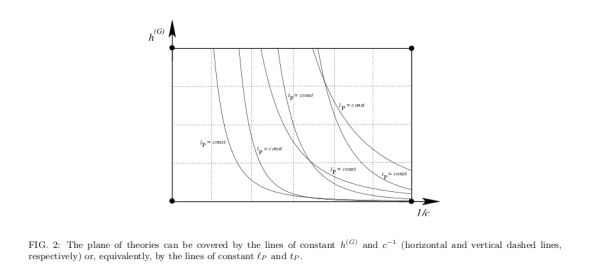
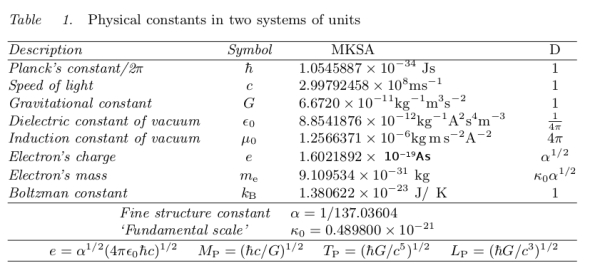
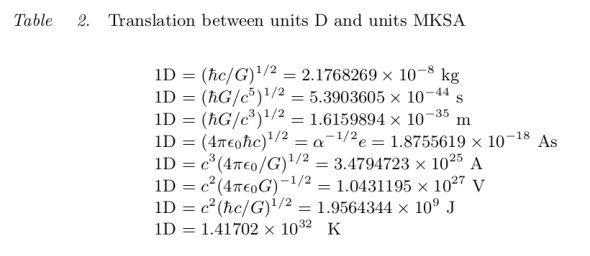
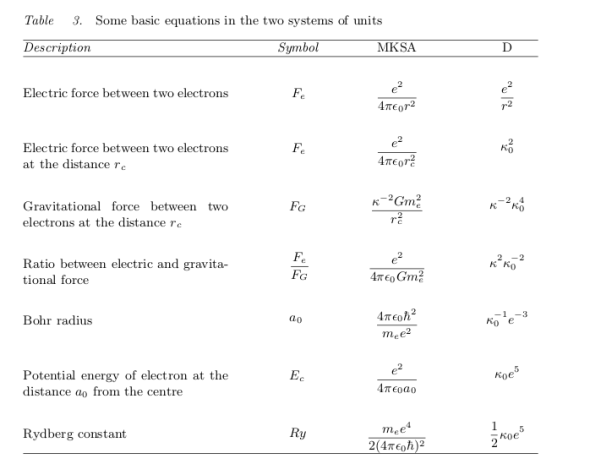
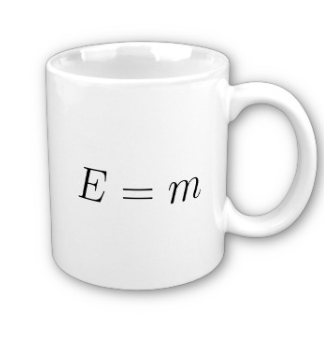
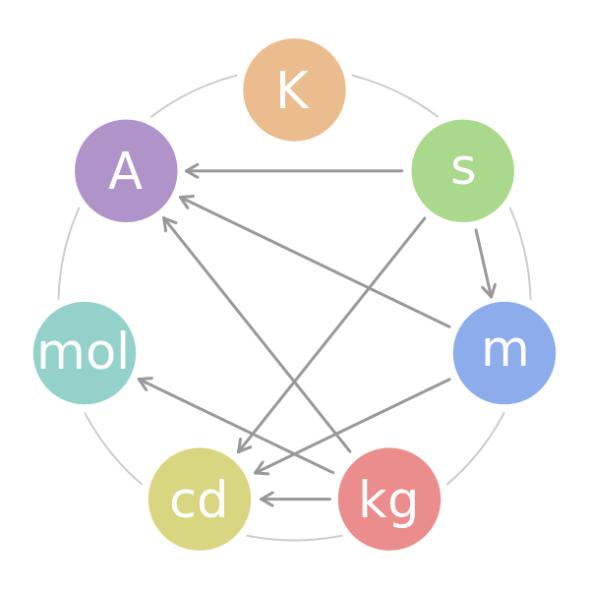
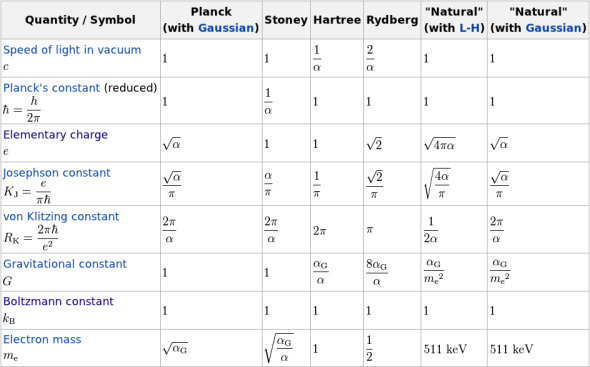
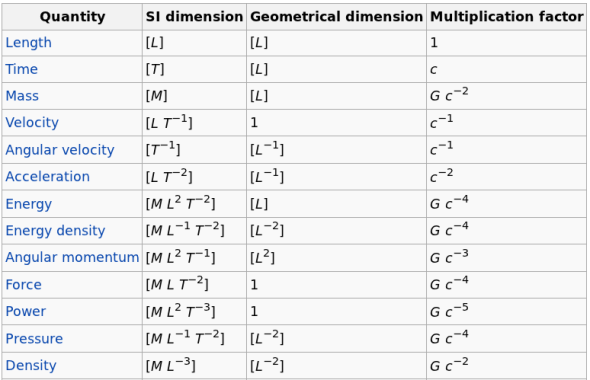

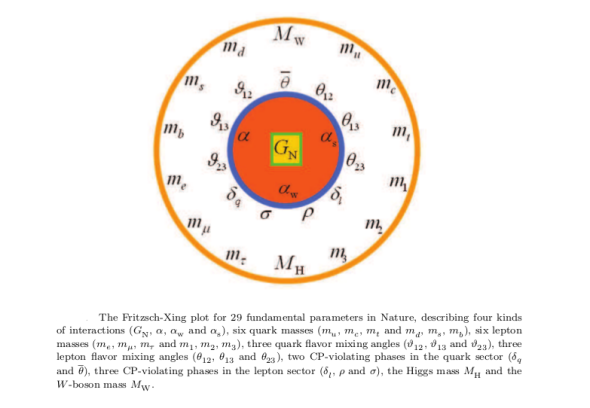
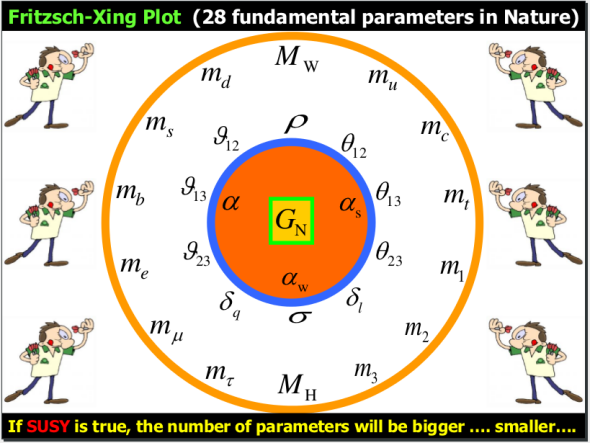
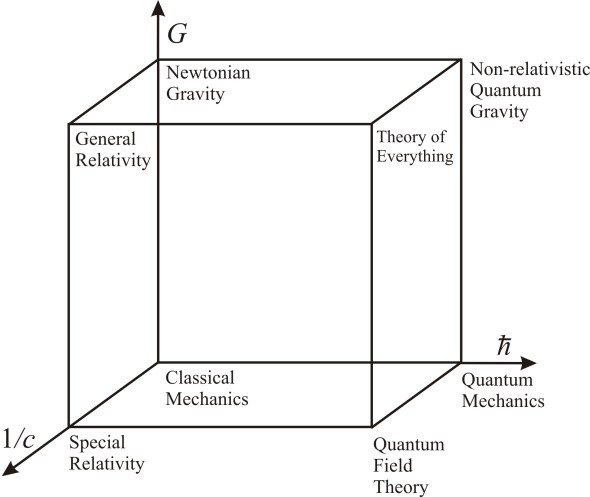
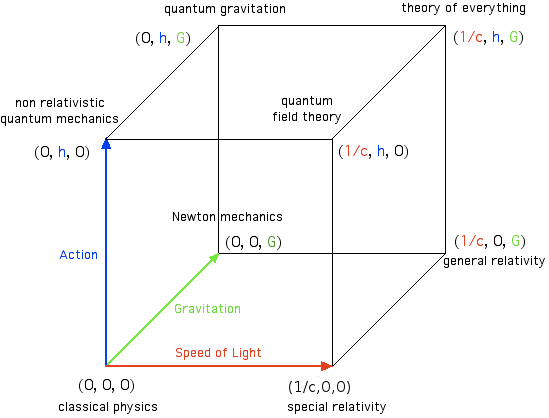

You must be logged in to post a comment.